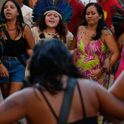Five bison roam the West Blean and Thornden Woods in Kent, slowly felling trees. The conifers, which were planted decades ago for cheap timber, have gradually replaced native oak, ash and willow, and destroyed the habitat of other wildlife by blocking the light. It’s vital that they are removed over time to avoid an explosion of bracken and bramble. A machine does some of the work. But the bison do it naturally—languidly rubbing against trees and stripping back bark to munch on, until the whittled-down trees naturally fall.
These are the first wild bison in Britain in 6,000 years. In the past few decades, bison have been reintroduced into the countryside across Europe, where 7,000 of them now roam “freely” in conservations—albeit kept away from the public by fences. Proponents of rewilding argue that forest ecosystems were managed better thousands of years ago by wild animals than they are today by costly, noisy machines, which easily disrupt other wildlife.
In July 2022, the Wildwood Trust and Kent Wildlife Trust released three female bison into the 1,000-acre woodland to test this out. In October, one bison unexpectedly birthed a calf; in December, a bull was added to the herd. This spring, Exmoor ponies, longhorn cattle and three iron-age pigs were introduced to the area.
“We want to manage the woodland, but we want to do it in a way that’s as natural as possible,” Simon Bateman-Brown, Kent Wildlife’s head of land management, explains. “And the solution that we’ve come up with is to have a variety of different animals, livestock, that will do that management for us. Because historically, thousands of years ago, those animals would have been here naturally doing that job.”
Centuries ago, bison roamed across most of Europe, but after hunting and habitat destruction their numbers dwindled, until the last wild bison was shot in the Caucasus in 1927. At the time, 54 European bison remained alive in captivity. The first bison was rewilded in 1954 in Poland, but the last 10 years have seen a surge of coordinated rewilding efforts by European conservation organisations in countries including Germany, Switzerland, Poland, Lithuania and the Netherlands.
Wildwood Trust staff travelled to a nature reserve in Netherlands to inspect its herd before attempting to bring wild bison to the UK. Using a studbook, or breed registry, they deliberately selected bison from different locations to prevent inbreeding: the matriarch (bison herds are typically matriarchal) hails from Highland Wildlife Park in the Cairngorms. The other two original female bison are Irish, while the bull is of German extraction. “Because bison come from such a small number of animals, they’re very carefully genetically screened,” says Paul Whitfield, director general of the Wildwood Trust.
The prospect of free-roaming bison still scares a lot of people. The Wilder Blean project has been forced to erect two fences—an outer barbed wire fence, and an inner electric one—to keep the bison away from the public. “Bison aren’t any more dangerous than any domestic cattle,” Bateman-Brown says. “But because they’re new to this country in this form, and because the UK government doesn’t have any real legislation to properly cover European bison, they are categorised as dangerous wild animals.” The Blean staff resent what they see as fearmongering—on our drive to the Blean, Sally Smith, a PR officer for Kent Wildlife Trust, brings up an old tabloid article comparing the project to Jurassic Park, which still stings.
Whitfield is similarly dismissive of fears about the animals’ ferocity. “People are completely free to move and interact with [American bison] across Yellowstone, and thousands of people every year do it,” he says. “And occasionally one idiot will try and take a selfie with a bison or stroke or bison. The bison will attack them because they're invading that animal’s space. But people who keep a distance are respected.”
A more realistic risk, however, is that herds of imported animals, left to breed naturally, could expand dramatically, throwing the ecosystem out of balance and destroying too much of the other wildlife. Rewilding is a relatively new project, and it hasn’t always gone well: on Oostvaardersplassen nature reserve in the Netherlands, thousands of wild deer, horses and cattle, who had been left almost totally unmanaged, died during a cold winter when vegetation ran out, and the wild animals could not migrate beyond the reserve’s 2,500-hectare grazing area. Herd numbers are now fiercely controlled.
On the day I visit the Blean, the five wild bison are nowhere to be seen. To get a sense of their stature, Bateman-Brown takes me to a nearby enclosure also owned by the Wildwood Trust, to see Haydes, a 15-year-old domesticated bison.
Haydes is around six foot tall and, I’m told, a “miserable bastard”. His pen-mate and sparring partner Orcz, who died earlier this year, was the approachable one.
Haydes rolls over on his back, producing a cloud of amber dust. This habit—dust bathing—is useful for woodland management, opening up spaces for insects to live. By the enclosure stands a thin, smooth pillar of wood which apparently used to be a tree trunk. A few kilometres away, Haydes’s wild cousins are busy felling several trees a day. In the paddock, his skills are useless.
Balefully, he heaves his 800kg body up to a standing position. The woolly head droops beneath the huge, sinewy shoulders as he ambles slowly into his hut.













